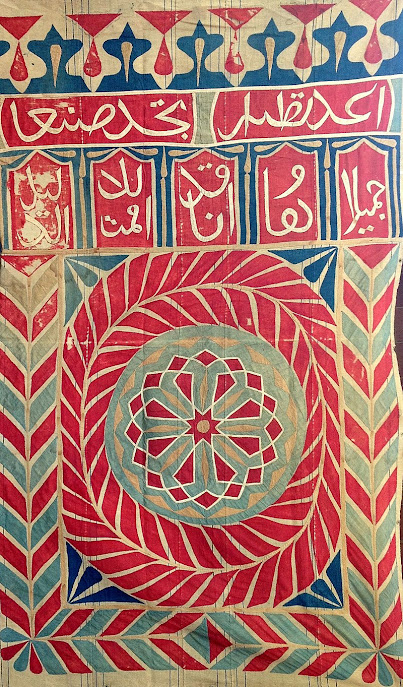The History of the Khayamiya
 |
| The Street of the Tentmakers in Cairo as seen in 1907 by Walter S.S. Tyrwhitt |
The Khayamiya is a market for quilted decorative works and printed fabrics that feature the imagery and design also known as Khayamiya.
This market is often referred to as the Tentmakers Alley. The tentmakers of history were generational artisans who used an applique technique to stitch elaborate and beautifully patterned tents for a variety of purposes, from troop encampments to religious festivals.
Khayamiya is a catch all term that refers to the market, the tent-making practice, the art form, design, and the handicraft items (applique) sold to home-makers and collectors. Until now the artisans are also called Khayamiya, or tentmakers.
The Tentmaker's Alley is located at Bab Zuela in Islamic Cairo, also known as Fatamid Cairo. Bab Zuwela is one of the walled gates of Islamic Cairo dating back to the 12th century AD. The market can be referred to with many names. Souq al Khayamia is the arabic; The Tent-maker's Alley is the equivalent in English. It is also called Khayamaya Alley, or Sharaa Al Khayamaya in Arabic. You can refer to the location using Bab Zuwela, and historians would say it's as located next to the Qasaba of Redwan Bey. If you're feeling intrepid just say "Fein Al Khayamaya" (where's the Khayamaya) and people will direct you.
,_Cairo._(1907)_-_TIMEA.jpg) |
| Festival tents (for Maulid Ahmadi) in Cairo featuring khayamiya, as depicted by Reginald Barratt in 1907 |
The market is easily 1000 years old. It's said to be one of the oldest covered markets Africa. The wooden roof covering the alley makes it a respite from Cairo's sun. The alley is filled with small stalls where craftsmen and shopkeepers keep their work. These stalls were once horse stables. When large caravans of goods came into Islamic Cairo for trade, they were carried by horses that needed to be stabled for days while merchants commenced trading and selling. By the 1900's the caravans were replaced with trucks, so these stables were repurposed as shops for tentmakers.
Few of these types of tents survive today, since they were not preserved. By the 18th century the demand for elaborate tents had declined, and the tentmakers began converting their skill into a decorative artform for the home. Furthermore, after the industrial revolution it became possible to print these patterns and designs on fabric much faster than they could be hand sewed. At this time tentmakers make functional works of craft featuring layers upon layers of stitched shapes.
Tents were essential to Arab life until the 1700's. City dwellers, including merchants, scholars, clerics, doctors, and politicians and artisans would also be familiar with the artform as tents were useful in urban life. Spanish cities are know for their plazas, where people can come to be addressed or entertained. Wide open spaces for public gathering. The Arab City was not built with this in mind, so even until now, tents are used to construct gathering spaces, within public spaces. A tent can turn a path or a small road into an event space, for something as fun as a wedding, to something as important as a political speech. In this way tent making has been an important part of desert life and city life for Arab people.
Tents in warfare
For much of the Islamic era, North Africa was still being conquered, and many inhabitants of the Sahara had not been converted to Islam. In a sense, this the desert was still the wild west. Between 650AD, when the city of Cairo was still being claimed by Amr Ibn Al Aas under the Khalif Abu Bakr, until late into the 18th century, Arab Muslims lived in clan based societies, many enjoying a nomadic life where they enjoyed freedom of movement.
In the old days of the Islamic empire, the tentmakers created tents for the Arab armies. Between 900 AD and 1700 A.D. warfare was common in the region. there were always battles for conquest, even Egypt was taken several times by different Muslim armies. By 11th century Salah el Din had conquered Egypt, and bought his armies to Jerusalem to take the city during the 2nd Crusade. His men were garrisoned outside Jerusalem for an extended period of time. The demand for tents kept the tentmakers critically involved in supporting the military.
Resources to learn more about Khayamia:
 |
| Egyptian scouts raising a decorated khayamiya tent at the 4th World Scout Jamboree in Budapest, Hungary in 1933 |
Resources to learn more about Khayamia:
.jpg)


Comments
Post a Comment